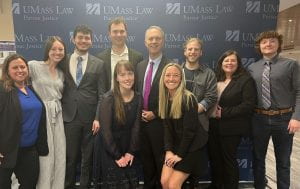By Lauren Thomas

Lauren Thomas, Spring 2023 CDC Fellow, in the UMass Law Library
A ground lease is a long-term commercial lease which typically lasts for 99 years [End Note 1]. With the ability to provide benefits to both landowners and tenants, in recent years, ground leases have gained traction for businesses and investors alike. [End Note 2]. While the process for creating a ground lease seems straightforward enough—draft a contract that is pleasing to both sides and sign—there are oftentimes wrinkles that require careful consideration by both parties. For example, what do you do if contained within the land to be leased is a building which is already being leased to another? And what if the landowner desires that already existing lease to remain in existence for a few more years?
Initially, the presence of an already existing lease on the land could seem to create quite the conundrum. Thankfully though it isn’t a deal breaker and there are several solutions to this otherwise troublesome situation. First, with the permission of the current tenant, the landowner could terminate the existing lease, sign the ground lease, and, so long as it was written in as a condition to the ground lease, require the developer to sign a new lease with the tenant. This however, comes with several risks as it requires not only an early termination of the existing lease, but also because it requires a mutual agreement between the tenant, landowner, and developer, something that each party rightfully might be very hesitant to agree to.
Second, the landowner could choose to hold off on signing the ground lease until the natural termination of the existing lease. This is perhaps the easiest solution depending on how long the term is for the existing lease. However, if the landowner wishes the current tenant to have an option to renew their lease, pushing back that natural termination even further, the landowner may miss out on a great opportunity to enter into a ground lease should the developer not also be willing to wait until the natural termination of the existing lease.
Third, the landowner could include a clause in the ground lease detailing that while the existing lease is not a part of the current ground lease, the ground lease may be amended to include that land at the time of the existing lease’s termination [End Note 3]. In essence, rather than approach the situation as it pertains to property law, the landowner would approach it as it relates to contract law—finding solace in a carefully drafted clause. The amendment would then be included as an exhibit to the ground lease which could easily be finalized and recorded when the time came. [End Note 4].
Which option makes the most sense? Although true that the third option requires a little bit more effort than options one or two, it is safe to say that it also provides the best security for every party involved. The landowner gets to keep their tenant, the tenant gets to keep their lease, and the developer and the landowner get to begin their ground lease.
—
- Michael Allan Wolf, Powell on Real Property §37.26 (2023)
- See generally Monte Mann, Ground Leases Offer Potential Benefits for both Tenants and Landowners, JDSupra, Jun. 9, 2022, https://www.jdsupra.com/legalnews/ground-leases-offer-potential-benefits-7432027/
- See U.S. Securities and Exchange Commission, https://www.sec.gov/Archives/edgar/data/1124610/000119312511208390/dex1026.htm (last visited Apr. 25, 2023).
- See U.S. Securities and Exchange Commission, https://www.sec.gov/Archives/edgar/data/908652/000119312505052626/dex1026.htm (last visited Apr. 25, 2023).














